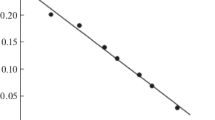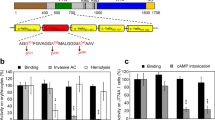Summary
The fluorescent anionic dye, bisoxonol, and flow cytometry have been used to monitor changes in the membrane potential of rat thymocytes exposed to the B subunit of cholera toxin. The B subunit induced a rapid hyperpolarization, which was due to activation of a Ca2+-sensitive K+ channel. Reduction of extracellular Ca2+ to <1 μm by the addition of [ethylenebis(oxyethylenenitrilo)]tetraacetic acid immediately abolished the hyperpolarization caused by the B subunit. Cells treated with quinine and tetraethylammonium lost their ability to respond to the B subunit, whereas 4-aminopyridine did not have any effect. Thus, calcium-sensitive and not voltage-gated K+ channels appeared to be responsible for the hyperpolarization. The results of ion substitution experiments indicated that extracellular Na+ was not essential for changes in membrane potential. Further studies with ouabain, amiloride and furosemide demonstrated that electrogenic Na+/K+ ATPase, Na+/H+ antiporter and Na+/K+/Cl− cotransporter, respectively, were not involved in the hyperpolarization process induced by the B subunit. Thus, crosslinking of several molecules of ganglioside GM1 on the cell surface of rat thymocytes by the pentavalent B subunit of cholera toxin modulated plasma membrane permeability to K+ by triggering the opening of Ca2+-sensitive K+ channels. A role for gangliosides in regulating ion permeability would have important implications for the function of gangliosides in various cellular phenomena.
Similar content being viewed by others
References
Berridge, M.J. 1984. Inositol triphosphate and diacylglycerol as second messengers.Biochem. J. 220:345–360
Berridge, M.J., Irvine, R.F. 1984. Inositol triphosphate, a novel second messenger in cellular signal transduction.Nature (London) 312:315–321
Damajanovich, S., Aszalos, A., Mulhern, S.A., Szollosi, J., Balazs, J., Tron, L., Fulwyler, M.J. 1987. Cyclosporin depolarizes human lymphocytes: Earliest observed effect on cell metabolism.Eur. J. Immunol. 17:763–768
De Coursey, T.E., Chandy, K.G., Gupta, S., Cahalan, M.D. 1984. Voltage-gated K+ channels in human T lymphocytes: A role in mitogenesis?Nature (London) 307:465–468
Dixon, S.J., Stewart, D., Grinstein, S., Spiegel, S. 1987. Transmembrane signaling by the B subunit of cholera toxin: Increased cytoplasmic-free calcium in rat thymocyte.J. Cell Biol. 105:1153–1161
Felber, S.M., Brand, M.D. 1983. Early plasma-membrane-potential changes during stimulation of lymphocytes by concanavalin A.Biochem. J. 210:885–891
Fishman, P.H., Brady, R.O. 1976. Biosynthesis and function of gangliosides.Science 194:906–915
Gorio, A., Carmignoto, G., Ferrari, G., Marini, P., Nunzi, M.G. 1983. Plasticity in neuronal regeneration: Implications for the role of exogenous gangliosides.In. Nervous System Regeneration. B. Haber, J.R. Perez-Polo, G.A. Hashim, A.M. Guiffrida-Stella, and N.W. Paul, editors. pp. 157–174. Alan R. Liss, New York
Hakomori, S. 1981. Glycosphingolipids in cellular interaction, differentiation, and oncogenesis.Annu. Rev. Biochem. 50:733–764
Hakomori, S. 1985. Aberrant glycosylation in cancer cell membranes as focused on glycolipids: Overview and perspectives.Cancer Res. 45:2405–2414
Kiefer, H., Blume, A.J., Kaback, R. 1980. Membrane potential changes during mitogenic stimulation of mouse spleen lymphocytes.Proc. Natl. Acad. Sci. USA 77:2200–2204
Ledeen, R.W. 1984. Biology of gangliosides: Neuritogenic and neuronotrophic properties.J. Neurosci. Res. 12:147–159
Lew, V.L., Ferreira, H.G. 1978. Calcium transport and the properties of a calcium-activated potassium channel in red cell membranes.Curr. Top. Membr. Transp. 10:217–277
Ludwig, D.S., Ribi, H.O., Schoolnik, G.K., Kornberg, R.D. 1986. Two-dimensional crystals of cholera toxin B-subunitreceptor complexes: Projected structure at 17-Å resolution.Proc. Natl. Acad. Sci. USA 83:8585–8588
Montecucco, C., Pozzant, T., Rink, T.J. 1979. Dicarboxyanine fluorescent probes of membrane potential block lymphocyte capping, deplete cellular ATP and inhibit respiration of isolated mitochondria.Biochim. Biophys. Acta 552:552–557
Moss, J., Richards, R.L., Alving, C.R., Fishman, P.H. 1977. Effect of the A and B protomers of choleragen on release of trapped glucose from liposomes containing or lacking ganglioside GM1.J. Biol. Chem. 252:797–798
Rink, T.J., Montecucco, C., Hesketh, T.R., Tsien, R.Y. 1980. Lymphocyte membrane potential assessed with fluorescent probes.Biochim. Biophys. Acta 595:15–30
Rink, T., Sanchez, A., Grinstein, S., Rothstein, A. 1983. Volume restoration in osmotically swollen lymphocyte does not involve changes in fre Ca2+ concentration.Biochim. Biophys. Acta 762:593–596
Schwartz, W., Passow, H. 1983. Ca2+-activated K+ channels in erythrocytes and excitable cells.Annu. Rev. Physiol. 45:359–374
Simons, T.J. 1976. Carbocyanine dyes inhibit Ca-dependent K efflux from human red cell ghosts.Nature (London) 264:467–469
Simons, T.J.B. 1979. Actions of a carbocyanine dye on calciumdependent potassium transport in human red cell ghosts.J. Physiol. (London) 228:481–507
Spiegel, S. 1984. Ganglioside involvement in lymphocyte stimulation.In: Cellular and Pathological Aspects of Glycoconjugate Metabolism. H. Dreyfus, R. Massarelli, L. Freysz, and G. Rebel, editors. Vol. 1126, pp 463–477. INSERM, Paris
Spiegel, S., Fishman, P.H. 1987. Gangliosides as bimodal regulators of cell growth.Proc. Natl. Acad. Sci. USA 84:141–147
Spiegel, S., Fishman, P.H., Mulhern, S.A. 1986a. Cytoplasmic membrane potential of lymphocytes is descreased by the B subunit of cholera toxin.Fed. Proc. 45:1882 (Abstr)
Spiegel, S., Fishman, P.H., Weber, R.J. 1985. Direct evidence that endogenous GM1 ganglioside can mediate thymocyte proliferation.Science 230:1285–1287
Spiegel, S., Handler, J.S., Fishman, P.H. 1986b. Gangliosides modulate sodium transport in cultured toad kidney epithelia.J. Biol. Chem. 261:15755–15760
Spiegel, S., Panagiotopoulos, C. 1988. Mitogenesis of 3T3 fibroblasts induced by endogenous ganglioside is not mediated by cAMP, protein kinase C, or phosphoinositides turnover.Exp. Cell Res. 177:414–427
Svennerholm, L. 1984. Biological significance of gangliosides.In: Cellular and Pathological Aspects of Glycoconjugate Metabolism. H. Dreyfus, R. Massarelli, L. Freysz, and G. Rebel, editors. Vol. 126, pp. 21–44. INSERM. Paris
Tatham, P.E.R., Delves, P.J. 1984. Flow cytometric detection of membrane potential changes in murine lymphocytes induced by concanavalin A.Biochem. J. 221:137–146
Tatham, P.E.R., O'Flynn, K., Linch, D.C. 1986. The relationship between mitogen-induced membrane potential changes and intracellular free calcium in human T-lymphocytes.Biochim. Biophys. Acta 845:202–211
Tsien, R.Y., Pozzan, T., Rink, T.J. 1982. T-cell mitogens cause early changes in cytoplasmic free Ca2+ and membrane potential in lymphocytes.Nature (London) 295:68–71
Wiegandt, H. 1982. The gangliosides.Adv. Neurochem. 4:149–223
Wilson, H.A., Chused, T.M. 1985. Lymphocyte membrane potential and Ca2+-sensitive potassium channels described by oxonol dye fluorescence measurements.J. Cell. Physiol. 125:72–81
Wilson, H.A., Seligmann, B.E., Chused, T.M. 1985. Voltagesensitive cyanine dye fluorescence signals in lymphocytes: Plasma membrane and mitochondrial components.J. Cell. Physiol. 125:61–71
Author information
Authors and Affiliations
Rights and permissions
About this article
Cite this article
Mulhern, D.A., Fishman, P.H. & Spiegel, S. Interaction of the B subunit of cholera toxin with endogenous ganglioside GM1 causes changes in membrane potential of rat thymocytes. J. Membrain Biol. 109, 21–28 (1989). https://doi.org/10.1007/BF01870787
Received:
Revised:
Issue Date:
DOI: https://doi.org/10.1007/BF01870787




